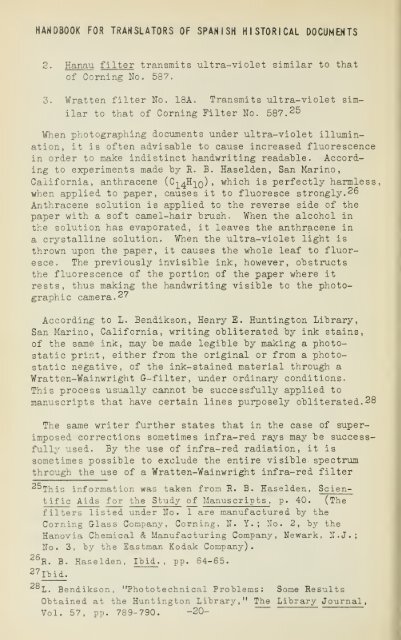Handbook for translators of Spanish historical ... - University Library
Handbook for translators of Spanish historical ... - University Library
Handbook for translators of Spanish historical ... - University Library
You also want an ePaper? Increase the reach of your titles
YUMPU automatically turns print PDFs into web optimized ePapers that Google loves.
HANDBOOK FOR TRANSLATORS OF SPANISH HISTORICAL DOCUMENTS<br />
2. Hanau filter transmits ultra-violet similar to that<br />
<strong>of</strong> Corning No. 587.<br />
3. Wratten filter No. 18A. Transmits ultra-violet similar<br />
to that <strong>of</strong> Corning Filter No. 587.25<br />
When photographing documents under ultra-violet illumination,<br />
it is <strong>of</strong>ten advisable to cause increased fluorescence<br />
in order to make indistinct handwriting readable. According<br />
to experiments made by R. B. Haselden, San Marino,<br />
Cali<strong>for</strong>nia, anthracene (Ci^H^q) > which is perfectly harmless,<br />
when applied to paper, causes it to fluoresce strongly. 26<br />
Anthracene solution is applied to the reverse side <strong>of</strong> the<br />
paper with a s<strong>of</strong>t camel-hair "brush. Vhen the alcohol in<br />
the solution has evaporated, it leaves the anthracene in<br />
a crystalline solution. When the ultra-violet light is<br />
thrown upon the paper, it causes the whole leaf to fluoresce.<br />
The previously invisible ink, however, obstructs<br />
the fluorescence <strong>of</strong> the portion <strong>of</strong> the paper where it<br />
rests, thus making the handwriting visible to the photographic<br />
camera. 27<br />
According to L. Bendikson, Henry E. Huntington <strong>Library</strong>,<br />
San Marino, Cali<strong>for</strong>nia, writing obliterated by ink stains,<br />
<strong>of</strong> the same ink, may be made legible by making a photostatic<br />
print, either from the original or from a photostatic<br />
negative, <strong>of</strong> the ink-stained material through a<br />
Wratten-Wainwright G-filter, under ordinary conditions.<br />
This process usually cannot be successfully applied to<br />
manuscripts that have certain lines purposely obliterated. 28<br />
The same writer further states that in the case <strong>of</strong> superimposed<br />
corrections sometimes infra-red rays may be successfully<br />
used. By the use <strong>of</strong> infra-red radiation, it is<br />
sometimes possible to exclude the entire visible spectrum<br />
through the use <strong>of</strong> a Wratten-Wainwright infra-red filter<br />
^^This in<strong>for</strong>mation was taken from E. B. Haselden, Scientific<br />
Aids <strong>for</strong> the Study <strong>of</strong> Manuscripts, p. 40. (The<br />
filters listed under No. 1 are manufactured "by the<br />
Corning Glass Company, Corning, N. Y. ; No. 2, "by the<br />
Hanovia Chemical A Manufacturing Company, Newark, N.J.;<br />
No. 3, "by the Eastman Kodak Company).<br />
^^R. B. Haselden, Ibid. ,<br />
27iMd_.<br />
pp.<br />
64-65.<br />
L. Bendikson, "Phototechnical Problems: Some Results<br />
Obtained at the Huntington <strong>Library</strong>," The <strong>Library</strong> Journal,<br />
Vol. 57, pp. 789-790. -20-










![Novellen [microform] - University Library](https://img.yumpu.com/21939450/1/171x260/novellen-microform-university-library.jpg?quality=85)
![Anecdota Chisiana de re metrica [microform]](https://img.yumpu.com/21939448/1/190x239/anecdota-chisiana-de-re-metrica-microform.jpg?quality=85)



![Schollenbruch [microform] : Gedichte - University Library](https://img.yumpu.com/21939437/1/174x260/schollenbruch-microform-gedichte-university-library.jpg?quality=85)

